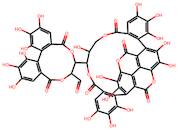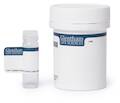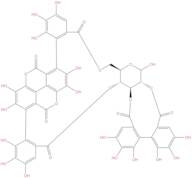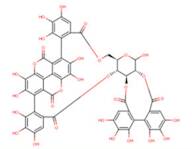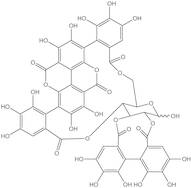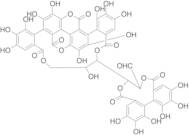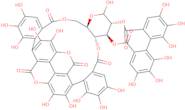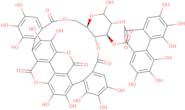CAS 65995-63-3: Punicalagin
Description:Punicalagin is a polyphenolic compound primarily found in pomegranates, particularly in the fruit's peel and juice. It belongs to a class of compounds known as ellagitannins, which are known for their antioxidant properties. Punicalagin is characterized by its ability to scavenge free radicals, thereby contributing to the health benefits associated with pomegranate consumption, such as anti-inflammatory and potential anti-cancer effects. The compound is soluble in water and exhibits a complex structure that includes multiple hydroxyl groups, which enhance its reactivity and biological activity. Punicalagin has garnered interest in nutritional and pharmaceutical research due to its potential therapeutic applications, including cardiovascular health and metabolic syndrome management. Additionally, it may influence gut microbiota composition, further contributing to its health-promoting effects. Overall, punicalagin is a significant bioactive compound that exemplifies the health benefits of pomegranate and its derivatives.
Formula:C48H28O30
InChI:InChI=1S/C48H28O30/c49-5-16-40(76-46(70)9-3-13(52)28(56)32(60)18(9)17-8(44(68)74-16)2-12(51)27(55)31(17)59)39-15(54)6-73-43(67)7-1-11(50)29(57)33(61)19(7)21-25-23-24-26(48(72)78-41(23)37(65)35(21)63)22(36(64)38(66)42(24)77-47(25)71)20-10(45(69)75-39)4-14(53)30(58)34(20)62/h1-5,15-16,39-40,50-66H,6H2
InChI key:InChIKey=SKNLUADAGHCXKF-UHFFFAOYSA-N
SMILES:O=CC1OC(=O)C2=CC(O)=C(O)C(O)=C2C3=C(O)C(O)=C(O)C=C3C(=O)OC1C4OC(=O)C5=CC(O)=C(O)C(O)=C5C6=C(O)C(O)=C7OC(=O)C=8C(=C(O)C(O)=C9OC(=O)C6=C7C98)C%10=C(O)C(O)=C(O)C=C%10C(=O)OCC4O
- Synonyms:
- 1,2,3,11,12,13-Hexahydroxy-5,10-Dioxo-8-[3,4,5,11,17,18,19,22,23,34,35-Undecahydroxy-8,14,26,31-Tetraoxo-9,13,25,32-Tetraoxaheptacyclo[25.8.0.02,7.015,20.021,30.024,29.028,33]Pentatriaconta-1(35),2,4,6,15,17,19,21,23,27,29,33-Dodecaen-10-Yl]-5,7,8,10-Tetrahydrodibenzo[F,H][1,4]Dioxecine-7-Carbaldehyde (Non-Preferred Name)
- 2,20,1,23-(Epoxy[2]propene[1,2]diyl[3]ylidene)-11H,15H-tribenzo[g,i,q][1,5,12]trioxacyclononadecin, <span class="text-smallcaps">D</span>-glucose deriv.
- <span class="text-smallcaps">D</span>-Glucose, cyclic 4,6-[(2S,2′S)-2,2′-(5,10-dihydro-2,3,7,8-tetrahydroxy-5,10-dioxo[1]benzopyrano[5,4,3-cde][1]benzopyran-1,6-diyl)bis[3,4,5-trihydroxybenzoate]] cyclic 2,3-[(1S)-4,4′,5,5′,6,6′-hexahydroxy[1,1′-biphenyl]-2,2′-dicarboxylate]
- <span class="text-smallcaps">D</span>-Glucose, cyclic 4,6-[(S,S)-2,2′-(5,10-dihydro-2,3,7,8-tetrahydroxy-5,10-dioxo[1]benzopyrano[5,4,3-cde][1]benzopyran-1,6-diyl)bis[3,4,5-trihydroxybenzoate]] cyclic 2,3-[(S)-4,4′,5,5′,6,6′-hexahydroxy[1,1′-biphenyl]-2,2′-dicarboxylate]
- <span class="text-smallcaps">D</span>-Glucose, cyclic 4,6-[2,2′-(5,10-dihydro-2,3,7,8-tetrahydroxy-5,10-dioxo[1]benzopyrano[5,4,3-cde][1]benzopyran-1,6-diyl)bis[3,4,5-trihydroxybenzoate]] cyclic 2,3-(4,4′,5,5′,6,6′-hexahydroxy[1,1′-biphenyl]-2,2′-dicarboxylate), [2(S),4(S,S)]-
- D-Glucose, cyclic 4,6-(2,2'-(5,10-dihydro-2,3,7,8-tetrahydroxy-5,10-dioxo(1)benzopyrano(5,4,3-cde)(1)benzopyran-1,6-diyl)bis(3,4,5-trihydroxybenzoate)) cyclic 2,3-(4,4',5,5',6,6'-hexahydroxy(1,1'-biphenyl)-2,2'-dicarboxylate)-, (2(S),4(S,S))-
- Dibenzo[f,h][1,4]dioxecin, <span class="text-smallcaps">D</span>-glucose deriv.
- Pomegranate extract
- Punicalagins
- D-Glucose, cyclic 4,6-[(2S,2′S)-2,2′-(5,10-dihydro-2,3,7,8-tetrahydroxy-5,10-dioxo[1]benzopyrano[5,4,3-cde][1]benzopyran-1,6-diyl)bis[3,4,5-trihydroxybenzoate]] cyclic 2,3-[(1S)-4,4′,5,5′,6,6′-hexahydroxy[1,1′-biphenyl]-2,2′-dicarboxylate]
- See more synonyms
- Dibenzo[f,h][1,4]dioxecin, D-glucose deriv.
- D-Glucose, cyclic 4,6-[2,2′-(5,10-dihydro-2,3,7,8-tetrahydroxy-5,10-dioxo[1]benzopyrano[5,4,3-cde][1]benzopyran-1,6-diyl)bis[3,4,5-trihydroxybenzoate]] cyclic 2,3-(4,4′,5,5′,6,6′-hexahydroxy[1,1′-biphenyl]-2,2′-dicarboxylate), [2(S),4(S,S)]-
- Punicalagin
- 2,20,1,23-(Epoxy[2]propene[1,2]diyl[3]ylidene)-11H,15H-tribenzo[g,i,q][1,5,12]trioxacyclononadecin, D-glucose deriv.

















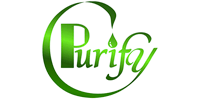




![D-Glucose, cyclic4,6-[(2S,2'S)-2,2'-(5,10-dihydro-2,3,7,8-tetrahydroxy-5,10-dioxo[1]benzopyrano[5,…](https://static.cymitquimica.com/products/IN/thumb/DA00IKLU.jpg)
